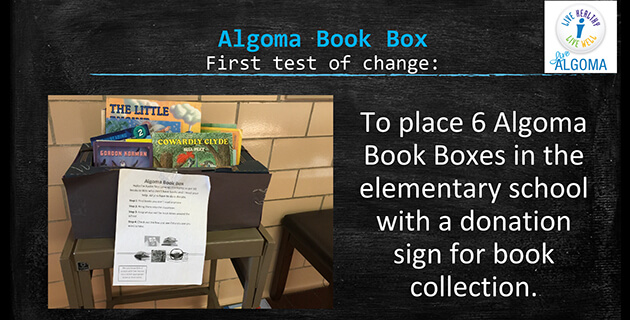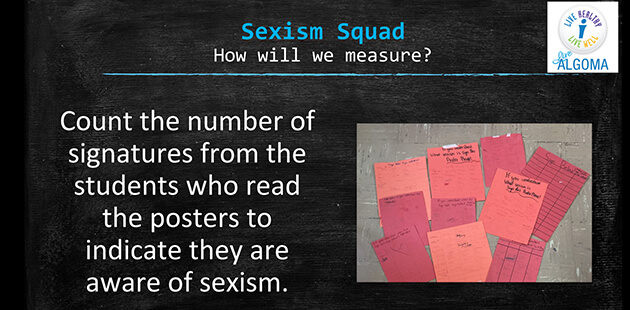Why It Matters

Teal VanLanen, a Wellness Coordinator and Community Activator in the Algoma, Wisconsin, school system, guided high school students through the IHI-HarvardX course, Practical Improvement Science in Healthcare earlier this year. How did it feel to watch the students succeed?
“It makes my heart beat loud,” she says. “To know that I am building the leadership capacities of our youth and empowering them to improve the world around them is exactly why I made the decision to ‘expand my classroom.’ Youth voice matters for so many reasons.”
VanLanen, a former fifth grade teacher in Algoma, a city of just over 3,000 people on the shores of Lake Michigan, reflected on the experience as she prepares to guide more students through the second offering of the MOOC (massive open online course).
Who came up with idea to have high school students take this course? In other words, who brought the MOOC to Algoma?
Thanks to a grant from IHI and the Robert Wood Johnson Foundation, Algoma became a SCALE (Spreading Communities Accelerators through Learning and Evaluation) Pacesetter Community. We adopted the name Live Algoma. We had access to lots of resources to build our leadership capacities and the improvement science MOOC, offered by IHI and HarvardX, was just one of those opportunities.
While members of the Live Algoma Activation Teams were taking the course to learn more about the PDSA cycle and how to apply it to our community work, students at Algoma High School were charged with a passion to make their own improvements in the community based on their own lived experience. I knew that these high school students needed the same learning opportunity in order to create real, sustainable change; therefore, I received permission for them to take the course and the students were ignited.
Can you give us a quick snapshot of Algoma and some of its challenges?
The City of Algoma experiences a range of challenges. Algoma has experienced an overall decline in population from over 4,000 in 1970 to 3,160 in 2016. Health services are limited with the closest hospital at least 25 miles away, relying on a volunteer rescue and fire service. We are in need of more physicians, dentists, and mental health services. Sixty-three percent of the school district students are eligible for free or reduced lunch, and third-party data indicate that 12 percent of the city’s children live in poverty.
How did you guide the students? Did they just take the course on their own? Did you come together for discussions?
At first, the students took the course on their own time. What we quickly realized by failing forward was that the students needed more. In order to continue the motivation and the passion, the students needed to collaborate, hold each other accountable, and offer support. We learned that making improvements can be challenging! Therefore, the students and I, with the permission of the Algoma Superintendent, Nick Cochart, created a “Harvard Scholar” course the second semester of the 2015-2016 school year. Having this course during the school day allowed the students to complete the coursework on their own time, and then come together for one hour each day to share their success stories, their obstacles, and offer ideas to others so that they could stay on track.
Did the students enjoy the course? Did they have a favorite part?
The students did enjoy the coursework. At times it was challenging and the reading was complex, but the students continued to push through it. Their favorite part were the videos as they gave concrete examples and were easy to follow. They also really enjoyed collaborating with other people from around the United States. This collaboration with other CEOs, doctors, directors, etc., around the world helped them feel connected and realize that others around our country are on a similar journey. They no longer felt isolated as high school students living in a rural community. Their voice mattered.
And the high school students that took the course are now teaching improvement to younger students?
Last year, most of the students who took the MOOC were seniors. As they were working through their improvement projects they could not help but think, “How are we going to make these improvements sustainable?” They wanted to complete a couple of PDSA cycles and then “pass it on to a junior.” However, they quickly realized that in order to really create sustainability and momentum, they had to teach the younger generation and engage them in this new way of thinking and being. As a result, the seniors taught a classroom full of sixth graders the PDSA cycle, in an age-appropriate way.
Those younger students worked on some great projects at the elementary school, including increasing book donations, increasing awareness of sexism, and increasing the amount of “ugly fruit” grocery stores donate.

How does this all make you feel as an educator?
Incredible. Amazing. Not only are these students leaders, but they are passionate, driven individuals with lived experience who don’t see the same obstacles adults do. They want to create an impact, and they have the necessary ingredients to do so. It takes educators like us to give them a few extra tools in their pocket, like improvement science, in order to make sustainable change in our community and the world around them.
Do you have any views on the potential of MOOCs to change education?
I think using MOOCs to educate students is profound, especially connecting students virtually with people from other states and countries, with people young and old, and with people from different cultural views. When this happens, students are not only learning the content that’s being presented, they are also learning the views of other people. They get to feel connected to the boarder world, and perhaps, make the connection that we are all in this together.
What's next? What's the future of this "MOOC" project?
The high school students that were involved last year recognized the need to continue the momentum and to build generative leaders. As a result, they developed a “blueprint” for youth engagement. The purpose of the blueprint is to believe in and empower kids to ignite their passion to make a difference in their community. The nine step blueprint includes: Dream Big Start Small, Create a Shared Vision for Tomorrow, Build Coalitions, Unity of Message, Moving Pillars of Power, Leave No One Who Wants to Be Involved with Us Behind, Develop Your Strategy and Tactics, Build Momentum, and Finish What You Started.
The most significant accomplishment of developing youth leadership is the creation of Pathfinder Academy. In the summer of 2016, the School District of Algoma purchased a building in the main street business district to physically integrate and nurture this process of student learning in the heart of downtown. This academy provides an interactive environment where students are self-directed and linked to the community. This hands-on approach to learning offers a progressive way of achieving knowledge and dreams. Right now, we have approximately 15 students participating at Pathfinder Academy, and we expect that number to grow as its reputation builds.
